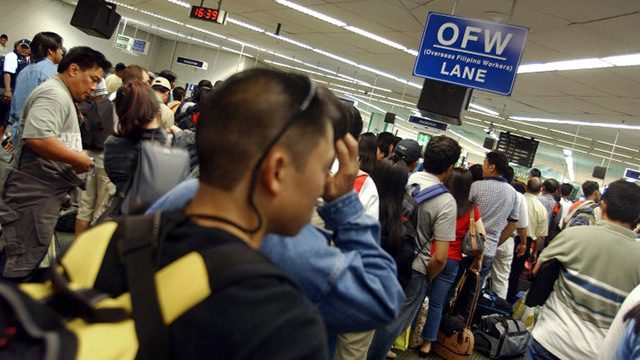SUMMARY
This is AI generated summarization, which may have errors. For context, always refer to the full article.

MANILA, Philippines – Philippine deployment of household service workers (HSWs) to foreign countries went down by 20% in the past 5 months compared to the same period in 2014.
The migration of 55,961 Filipino domestic workers from January to May was regarded as “good news” by the labor department, given the more substantial 70,034 HSWs deployed in the same months last year.
HSWs are considered among the vulnerable and prone-to-abuse overseas Filipino workers (OFWs). (READ: DFA: 3 challenges in protecting female domestic workers)
Labor Secretary Rosalinda Baldoz said the “preliminary” government data was a welcome development, attributing the decline to “relentless” pro-OFW government reforms.
“Our household service workers reform package is working and I would like a long-term effect of the measures in the package to really move our HSWs from home-based occupations to occupations that not only pay good salaries and benefits, but also guarantee their protection,” said Baldoz in a statement.
The Cabinet official is in Geneva for the 104th International Labor Conference.
Impact assessment
The “encouraging data” may be due to the strict approval of HSW job orders since January, said Baldoz.
Baldoz cited other government efforts, such as the enforcement of a standard employment contract providing a monthly minimum wage of $400, the implementation of the no-placement-fee policy for HSWs, and the mandatory training of HSWs.
Since January, Philippine Overseas Labor Offices have also conducted training programs aligned with the Technical Education and Skills Development Authority.
On-site certification has been made available for distressed HSWs at Filipino Workers Resource Centers.
Baldoz ordered an impact assessment to ascertain if these reforms had anything to do with the “encouraging data” of decreased HSW deployment.
An agreement with Saudi Arabia to make the recruitment process electronic – from validating job orders to releasing employment contracts – is also underway, Rappler learned.
Kafala system
In a report transmitted to Baldoz, Philippine Overseas Employment Administration (POEA) chief Hans Leo Cacdac said the Kingdom of Saudi Arabia and the United Arab Emirates topped the list of destination countries with the greatest decline in HSW deployment.
| COUNTRY | Jan-May 2014 HSW deployment | Jan-May 2015 HSW deployment |
| Saudi Arabia | 26,570 | 20,949 |
| United Arab Emirates | 13,440 | 215 |
| Hong Kong | 8,409 | 5,825 |
| Singapore | 4,853 | 3,798 |
| Bahrain | 2,029 | 1,982 |
| Malaysia | 4,179 | 1,725 |
| Cyprus | 424 | 322 |
| Brunei | 273 | 147 |
| Macau | 143 | 75 |
Both Saudi Arabia and the UAE enforce the kafala system, a visa sponsorship set-up largely seen as oppressive of migrant workers.
Under the kafala visa sponsorship, the employer’s consent is needed before a migrant worker can change jobs or be granted an exit permit to go back to his or her home country.
Migrant workers are forced to give in to demands of unpaid or involuntary labor, among others, just to obtain the necessary permit from their employer. Many domestic workers find themselves in dire working conditions. (READ: Qatar to junk oppressive visa system for OFWs)
The government foresees that the use of mega-recruiters or large-scale recruitment entities in Gulf states could counter the ill effects of kafala.
The Philippines is known labor-sending country.
Over 10.5 million Filipinos are either temporarily working or permanently residing abroad, according to the 2013 Commission on FIlipinos Overseas compendium. More recent estimates peg the number at 15 million.
While OFWs’ remittances boost the economy, President Benigno Aquino III envisions “a government that creates jobs at home so that working abroad will be a choice rather than a necessity.” – Rappler.com
Add a comment
How does this make you feel?
There are no comments yet. Add your comment to start the conversation.